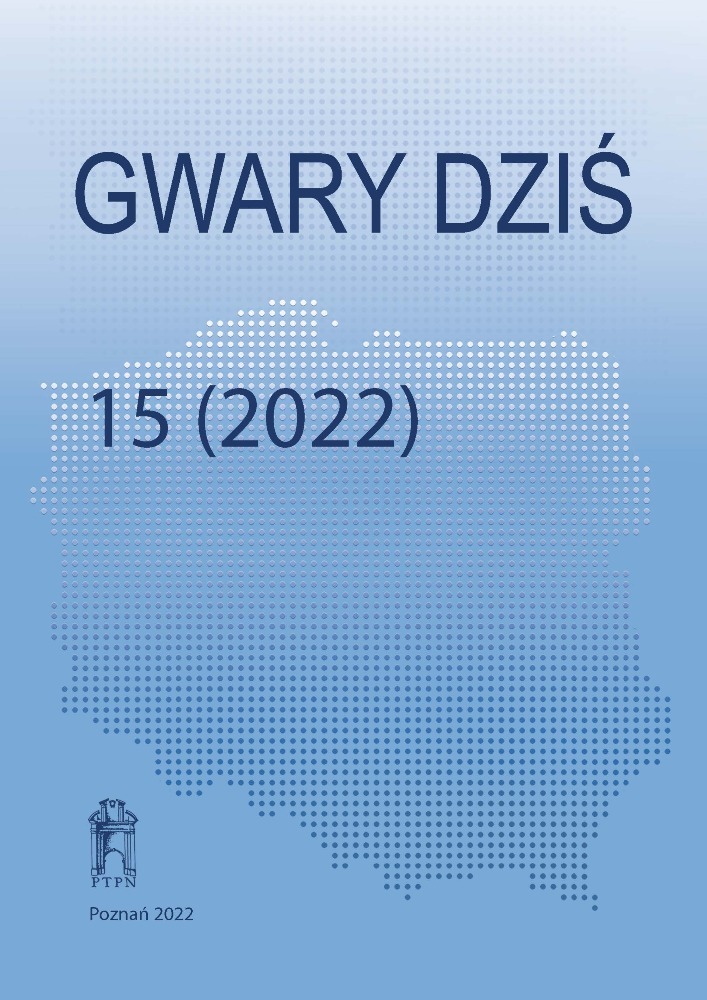Abstract
The article discusses the orthography and spelling in questionnaires for the German Language Atlas written in the 1880s in the central and eastern parts of contemporary Masuria, a region in the north-east of Poland. The questionnaires contain translations of 40 German sentences (compiled by Georg Wenker, a librarian from Marburg) into the local dialect. With regard to the spelling and orthography, the material analysed takes into account, among other things, the occurrence of é, e.g. lepiéj, Śniég, the use of j to denote g, e.g. inaczeg, jagka, nag więczey, also as a result of asynchronous pronunciation of soft labial consonants, e.g. c’ezegenc’, dschischag, dzegenc ‘dziewięć’. The text highlights the wide variety of renditions in writing of the y vowel, e.g. y᷆, ӳ, ỳ, ÿ, ў. Examples are provided of German-related spelling, e.g. with the use of z instead of c: zalezarno ‘całe czarno’, uzuł ‘najwięcej się uczył’; tz instead of c: motzno, umentzone. The questionnaires under discussion clearly show the persistence of old Polish spelling traditions, while on the other hand they indicate the influence of German orthography.
References
Bajerowa I. (1986), Polski język ogólny XIX wieku. Stan i ewolucja, t. I: Ortografia. Fonologia z fonetyką. Morfonologia, Katowice.
Cherek A. (2003, 2004), Zakresy użycia wielkich liter w drukach krakowskich pierwszej ćwierci XVII wieku, „Poznańskie Studia Polonistyczne. Seria Językoznawcza”, cz. I, X (XXX) 2003, s. 89–107; cz. II, XI (XXXI), 2004, s. 33–53.
Cybulski M. (2010), Na obrzeżach głównego nurtu. O grafii urzędowych rękopisów staropolskich, [w:] Dokument pisany w badaniach historyka języka polskiego. Z badań nad grafią i fonetyką historycznej polszczyzny, red. M, Kuźmicki, M. Osiewicz, Zielona Góra–Poznań, s. 167–188.
Feleszko K., Siatkowski J. (1994), Polskie XIX-wieczne materiały gwarowe w Marburgu, „Rocznik Towarzystwa Naukowego Warszawskiego”, t. 45, s. 52–57.
Grygier T. (1961), Z dziejów szkolnictwa wiejskiego na Mazurach i Warmii w pierwszej połowie XIX wieku (na podstawie materiałów Wojewódzkiego Archiwum Państwowego w Olsztynie), „Komunikaty Mazursko-Warmińskie”, nr 2, s. 220–253.
Hammel R. (2020). Das Polnische und Kaschubische in der Fragebogenerhebung Georg Wenkers, [w:] Minderheitensprachen und Sprachminderheiten. Deutsch und seine Kontaktsprachen in der Dokumentation der Wenker-Materialien, Hrsg. J. Fleischer, A. Lameli, Ch. Schiller, L. Szucsich, Marburg, s. 413–474.
Kępińska A. (2010), Wiedza historycznojęzykowa a edycje tekstów staropolskich (na przykładachz fryburskiego Rozmyślania przemyskiego), [w:] Dokument pisany w badaniach historyka języka polskiego. Z badań nad grafią i fonetyką historycznej polszczyzny, red. M. Kuźmicki, M. Osiewicz, Zielona Góra–Poznań, s. 31–70.
Martuszewski E. (1979), Preparandy nauczycielskie na Mazurach w pierwszej połowie XIX wieku, „Komunikaty Mazursko-Warmińskie”, nr 1, s. 11–40.
Martuszewski E. (2001), „Die polnische Sprachfrage in Preussen” Gustawa Gizewiusza jako źródło do badań nad dziejami germanizacji szkolnictwa na Mazurach, Olsztyn.
Paluszak-Bronka A. (2006), Uwagi o grafii i ortografii w tzw. kancjonale mazurskim, „Linguistica Bigdostiana”, s. 171–184.
Popowska-Taborska H., Rzetelska-Feleszko E. (2009), Dialekty kaszubskie w świetle XIX-wiecznych materiałów archiwalnych: prezentacja i opracowanie kaszubskich materiałów językowych zebranych przez Georga Wenkera w latach 1879–1887, Warszawa.
Rembiszewska D.K. (2020), Gwary Mazur wschodnich w XIX wieku (na podstawie ankiet Georga Wenkera do Niemieckiego atlasu językowego), Warszawa.
Stone G. (1990), Polskie materiały dialektyczne w archiwum Niemieckiego atlasu językowego w Marburgu, „Język Polski”, z. 70 (3–4), s. 124–127.
Sudetendeutsche Wörterbuch. Wörterbuch der deutschen Mundarten in Böhmen und Mähren-Schlesien, B. I–IV, München 1976–2010.
License
Copyright (c) 2022 Dorota Krystyna Rembiszewska

This work is licensed under a Creative Commons Attribution-NoDerivatives 4.0 International License.
Authors
Authors of texts accepted for publication in „Gwary Dziś" are required to complete, sign and return to the editor's office the Agreement for granting a royalty-free license to works with a commitment to grant a CC sub-license.
Under the agreement, the authors of texts published in „Gwary Dziś" grant the Adam Mickiewicz University in Poznań a non-exclusive, royalty-free license and authorize the use of Attribution-NoDerivatives 4.0 International (CC BY-ND 4.0) Creative Commons sub-license.
The authors retain the right to continue the free disposal of the work.
Users
Interested Internet users are entitled to use works published in „Gwary Dziś" since 2016 under the following conditions:
- attribution - obligation to provide, together with the distributed work, information about the authorship, title, source (link to the original work, DOI) and the license itself.
- no derivatives - the work must be preserved in its original form, without the author's consent it is not possible to distribute the modified work, such as translations, publications, etc.
Copyrights are reserved for all texts published before 2015.
Miscellaneous
Adam Mickiewicz University in Poznań retains the right to magazines as a whole (layout, graphic form, title, cover design, logo etc.).

